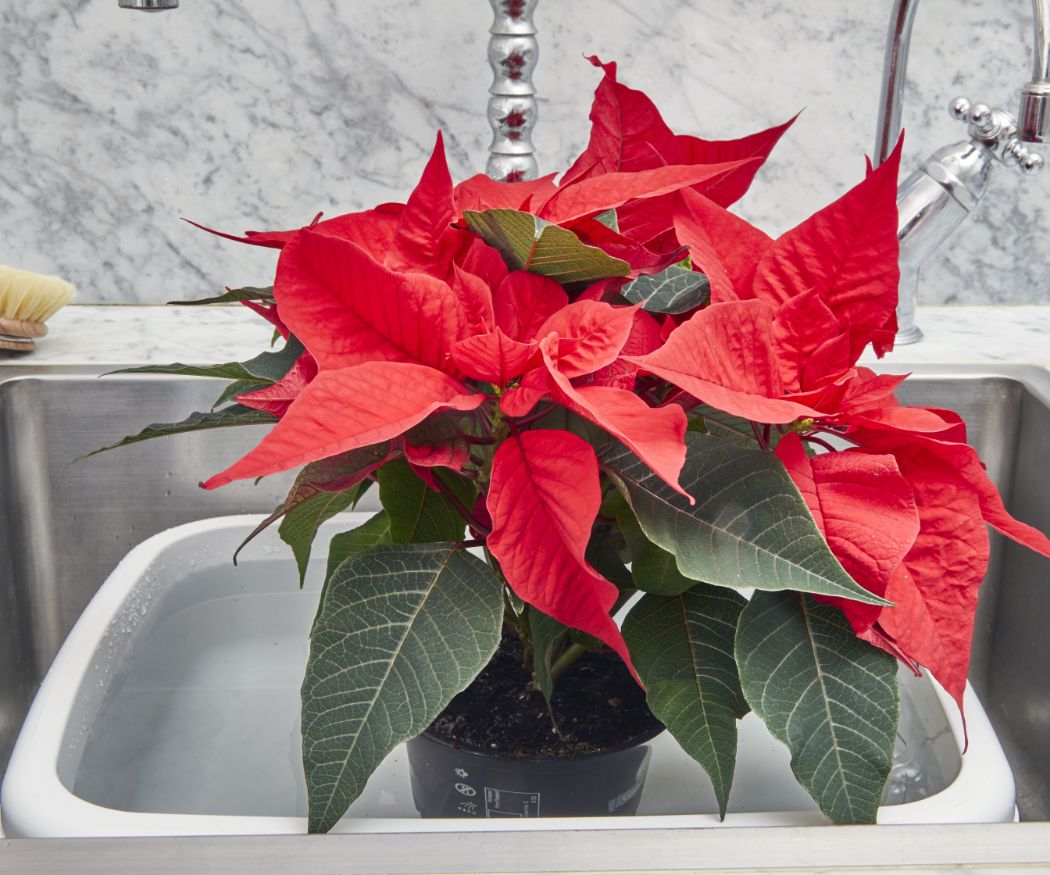
• Don’t water your poinsettia until the soil has dried out.
• The amount of water for a standard poinsettia in a 13cm pot is about 100ml; about as much as a champagne flute.
• The right amount for a mini poinsettia in a 6cm pot is half a shot glass of water; about 10ml
• If possible, use room-temperature, soft water.
• After about 15 minutes, drain any excess water from the drip tray or planter to prevent waterlogging.
How do I know when to water my poinsettia?
Don’t water your poinsettia until the soil has dried out. There are three ways to tell when is the ideal time to water:
1.) Finger test: Stick a finger into the soil. If it feels warm and dry and doesn’t stick to your finger, it’s time to water.
2.) Weight check: Lift the pot. If it feels unexpectedly light, your poinsettia needs water.
3.) Look at the colour of the compost: It will look more light brown than dark brown when it’s time to water.
How much water does a poinsettia need?
For a standard poinsettia in a 12 or 13cm pot, we recommend 100ml per watering. This is the same as a champagne flute. For a mini poinsettia, 10ml is enough. This corresponds to half a small shot glass. XXL poinsettias in larger pots need more water. Between 10 and 20 percent of the pot volume is best.

How often do I need to water my poinsettia?

It’s impossible to say how often you need to water your poinsettia in general terms. From daily to once a week, anything is possible. It depends on various factors. These are:
• Room temperature: the warmer it is, the more often you need to water.
• Humidity: The drier the air, the more often your poinsettia will need water.
• Pot size: The smaller the volume of soil, the sooner you’ll have to reach for the watering can. Mini poinsettias, therefore, need watering more often than large ones.
• Watering method: An immersion bath usually lasts longer than watering with a can.
You just have to watch your poinsettia and find the right rhythm for YOUR conditions. Simply watering more but less often is not an option, as poinsettias don’t like to be waterlogged.
How does waterlogging occur and how do I avoid it?
If excess water can’t drain off, waterlogging occurs. If the soil gets completely soaked, air can no longer reach the roots. The result is yellow, limp leaves and an uncertain fate for your poinsettia.
To prevent this happening, make sure excess water can drain away.
• For containers you plant up yourself, ensure the container can drain and provide a drainage layer if possible.
• Remove excess liquid from the drip tray or planter about 15 minutes after watering.
• Reduce the amount of water you give if there’s always some left behind in the drip tray or planter afterwards.
If, during watering, the liquid runs out into the drip tray and the dried root ball takes it up from there, that’s okay, as long as you remove the rest after 15 minutes. Poinsettia nurseries do something similar. They use the principle of accumulation irrigation and flood the growing tables. After a short time, the water is drained off again.
Poinsettias prefer room temperature water
As warmth-loving, tropical houseplants, poinsettias react badly to cold water. Always refill your watering can immediately after watering so the liquid has reached room temperature by the next time you use it.
Soft water keeps poinsettias healthy
Poinsettias prefer soft water. Water from a rain barrel or melted snow is ideal (just make sure you bring it to room temperature before watering). In areas with hard drinking water, you can use a filter for removing calcium and chlorine. You can also boil tap water, as the calcium remains as limescale in the kettle (let the water cool down before pouring).
What’s the best way to water a poinsettia?
You can water your poinsettia in different ways: from above with a watering can, from below or by immersion.
Watering from above
Classic watering from above is probably the most common. Watering with a good old watering can has the advantage that you control the amount. Plus, you don’t have to move your poinsettia. Be careful not to damage the leaves with the watering can.


Watering from below
When watering from below, add room-temperature water to the drip tray or planter daily or every two to three days, depending on the location and plant size.
This allows your poinsettia to soak up the amount of water it needs.
When you notice the water level remains unchanged for about 15 minutes, remove the excess from the drip tray or planter. With this method, the soil surface often still appears dry after watering.
However, when you lift the pot, you will notice by the weight that there is enough moisture in the soil. Watering from below is particularly gentle on the sensitive roots.
Soaking by immersion
Another method is by immersion, which should be done about once a week, depending on the plant size, ambient temperature and location. The immersion method is often the only way to effectively moisten severely dried-out compost again.
Here’s how to do it:
• Take your poinsettia out of its planter, but keep it in its plastic pot. Place it in a deep bowl or bucket of room-temperature water. Make sure the root ball is just below the surface of the water. As the water flows into the compost, bubbles will rise.
• Wait until virtually no more bubbles appear. Only then is the compost properly saturated with water.

• Allow your poinsettia to drain well.
• Put it back in its place.
• After 15 minutes, empty any excess water from the drip tray or planter to avoid waterlogging.
What do I do about limp, green poinsettia leaves?
If a poinsettia’s foliage droops, the soil is too dry. The roots don’t have enough water to send to the leaves. First individual plant cells die, then the whole poinsettia. If the soil dries out so much that it comes away from the edge of the pot, it’s doubtful whether the plant can still be saved by watering.
Tip: Take extra care with mini poinsettias! Because the pot volume is small, the soil dries out very quickly. This applies to all mini plants 😉. For more tips on caring for mini poinsettias, see the blog “Mini poinsettias: gift ideas and care tips”.
What do I do about limp, yellow poinsettia leaves?
Floppy, YELLOW leaves are what a poinsettia gets from too much water, not too little. They are the most obvious symptom of the notorious waterlogging. Under no circumstances give the poinsettia more water. Check to see if there’s liquid in the planter or drip tray. If so, pour it away and don’t water again until the soil has dried out. If you’re lucky, your poinsettia will recover 😊.
